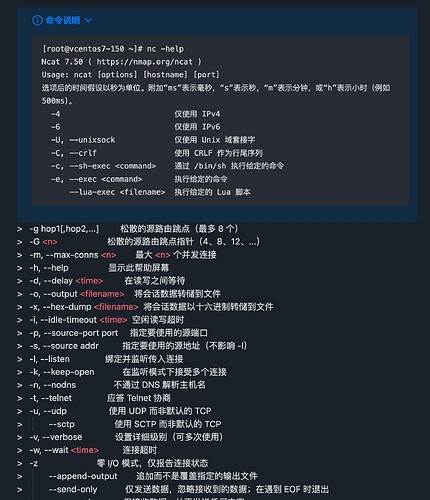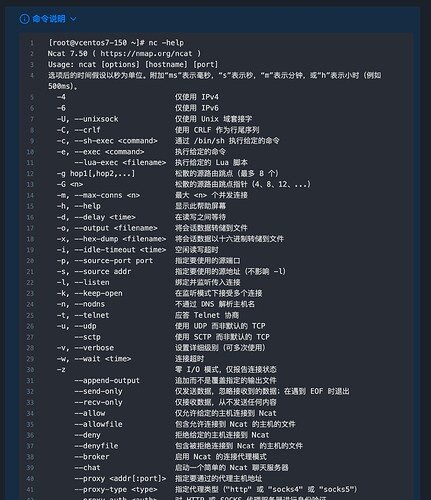Callout 编辑模式中渲染代码块有问题
版本:v1.8.10
系统:MacOS 15.4.1
需处理的文本
> [!info]- 命令说明
>
> ```
> [root@vcentos7-150 ~]# nc -help
> Ncat 7.50 ( https://nmap.org/ncat )
> Usage: ncat [options] [hostname] [port]
> 选项后的时间假设以秒为单位。附加“ms”表示毫秒,“s”表示秒,“m”表示分钟,或“h”表示小时(例如 500ms)。
> -4 仅使用 IPv4
> -6 仅使用 IPv6
> -U, --unixsock 仅使用 Unix 域套接字
> -C, --crlf 使用 CRLF 作为行尾序列
> -c, --sh-exec <command> 通过 /bin/sh 执行给定的命令
> -e, --exec <command> 执行给定的命令
> --lua-exec <filename> 执行给定的 Lua 脚本
> -g hop1[,hop2,...] 松散的源路由跳点(最多 8 个)
> -G <n> 松散的源路由跳点指针(4、8、12、...)
> -m, --max-conns <n> 最大 <n> 个并发连接
> -h, --help 显示此帮助屏幕
> -d, --delay <time> 在读写之间等待
> -o, --output <filename> 将会话数据转储到文件
> -x, --hex-dump <filename> 将会话数据以十六进制转储到文件
> -i, --idle-timeout <time> 空闲读写超时
> -p, --source-port port 指定要使用的源端口
> -s, --source addr 指定要使用的源地址(不影响 -l)
> -l, --listen 绑定并监听传入连接
> -k, --keep-open 在监听模式下接受多个连接
> -n, --nodns 不通过 DNS 解析主机名
> -t, --telnet 应答 Telnet 协商
> -u, --udp 使用 UDP 而非默认的 TCP
> --sctp 使用 SCTP 而非默认的 TCP
> -v, --verbose 设置详细级别(可多次使用)
> -w, --wait <time> 连接超时
> -z 零 I/O 模式,仅报告连接状态
> --append-output 追加而不是覆盖指定的输出文件
> --send-only 仅发送数据,忽略接收到的数据;在遇到 EOF 时退出
> --recv-only 仅接收数据,从不发送任何内容
> --allow 仅允许给定的主机连接到 Ncat
> --allowfile 包含允许连接到 Ncat 的主机的文件
> --deny 拒绝给定的主机连接到 Ncat
> --denyfile 包含被拒绝连接到 Ncat 的主机的文件
> --broker 启用 Ncat 的连接代理模式
> --chat 启动一个简单的 Ncat 聊天服务器
> --proxy <addr[:port]> 指定要通过的代理主机地址
> --proxy-type <type> 指定代理类型("http" 或 "socks4" 或 "socks5")
> --proxy-auth <auth> 对 HTTP 或 SOCKS 代理服务器进行身份验证
> --ssl 以 SSL 连接或监听
> --ssl-cert 指定用于监听的 SSL 证书文件(PEM 格式)
> --ssl-key 指定 SSL 私钥(PEM 格式)
> --ssl-verify 验证证书的信任和域名
> --ssl-trustfile 包含受信任的 SSL 证书的 PEM 文件
> --ssl-ciphers 包含要使用的 SSL 密码的密码列表
> --version 显示 Ncat 的版本信息并退出
>
> 请查看 ncat(1) 的手册页以获取完整的选项、说明和使用示例
>
> [root@vcentos7-150 ~]# nc -help
> Ncat 7.50 ( https://nmap.org/ncat )
> Usage: ncat [options] [hostname] [port]
>
> Options taking a time assume seconds. Append 'ms' for milliseconds,
> 's' for seconds, 'm' for minutes, or 'h' for hours (e.g. 500ms).
> -4 Use IPv4 only
> -6 Use IPv6 only
> -U, --unixsock Use Unix domain sockets only
> -C, --crlf Use CRLF for EOL sequence
> -c, --sh-exec <command> Executes the given command via /bin/sh
> -e, --exec <command> Executes the given command
> --lua-exec <filename> Executes the given Lua script
> -g hop1[,hop2,...] Loose source routing hop points (8 max)
> -G <n> Loose source routing hop pointer (4, 8, 12, ...)
> -m, --max-conns <n> Maximum <n> simultaneous connections
> -h, --help Display this help screen
> -d, --delay <time> Wait between read/writes
> -o, --output <filename> Dump session data to a file
> -x, --hex-dump <filename> Dump session data as hex to a file
> -i, --idle-timeout <time> Idle read/write timeout
> -p, --source-port port Specify source port to use
> -s, --source addr Specify source address to use (doesn't affect -l)
> -l, --listen Bind and listen for incoming connections
> -k, --keep-open Accept multiple connections in listen mode
> -n, --nodns Do not resolve hostnames via DNS
> -t, --telnet Answer Telnet negotiations
> -u, --udp Use UDP instead of default TCP
> --sctp Use SCTP instead of default TCP
> -v, --verbose Set verbosity level (can be used several times)
> -w, --wait <time> Connect timeout
> -z Zero-I/O mode, report connection status only
> --append-output Append rather than clobber specified output files
> --send-only Only send data, ignoring received; quit on EOF
> --recv-only Only receive data, never send anything
> --allow Allow only given hosts to connect to Ncat
> --allowfile A file of hosts allowed to connect to Ncat
> --deny Deny given hosts from connecting to Ncat
> --denyfile A file of hosts denied from connecting to Ncat
> --broker Enable Ncat's connection brokering mode
> --chat Start a simple Ncat chat server
> --proxy <addr[:port]> Specify address of host to proxy through
> --proxy-type <type> Specify proxy type ("http" or "socks4" or "socks5")
> --proxy-auth <auth> Authenticate with HTTP or SOCKS proxy server
> --ssl Connect or listen with SSL
> --ssl-cert Specify SSL certificate file (PEM) for listening
> --ssl-key Specify SSL private key (PEM) for listening
> --ssl-verify Verify trust and domain name of certificates
> --ssl-trustfile PEM file containing trusted SSL certificates
> --ssl-ciphers Cipherlist containing SSL ciphers to use
> --version Display Ncat's version information and exit
>
> See the ncat(1) manpage for full options, descriptions and usage examples
> ```
编辑模式下的渲染效果
渲染不全
预期的效果
期望的编辑模式输出效果是和阅读模式一样的完全渲染

